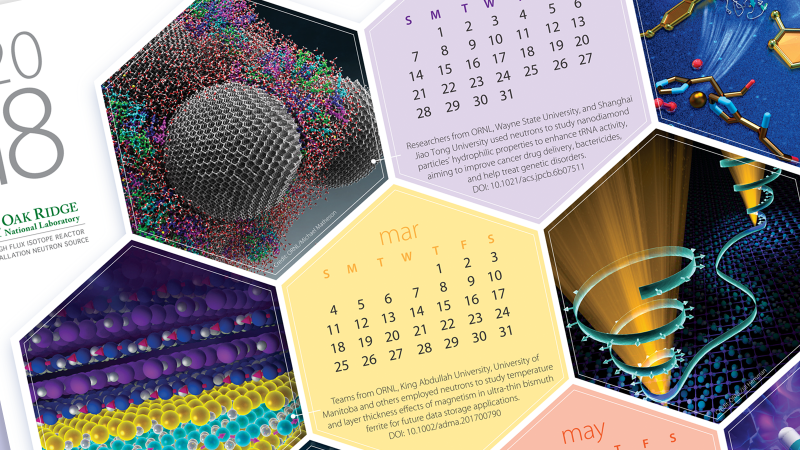Neutron Sciences 2018 poster is now available. The poster highlights 12 examples of research from SNS and HFIR. You can download a printable version of the poster here.
For more information on the scientific research and publications featured each month, visit these links:
January: Researchers from ORNL, Wayne State University, and Shanghai Jiao Tong University used neutrons to study nanodiamond particles’ hydrophilic properties to enhance tRNA activity, aiming to improve cancer drug delivery, bactericides, and help treat genetic disorders.
February: Scientists from ORNL, University of Tennessee, and North Carolina State University used neutrons to help describe molecular oxygen activation by enzymes, which could lead to more efficient enzymatic processing of plant-based materials into biofuels.
March: Teams from ORNL, King Abdullah University, University of Manitoba and others employed neutrons to study temperature and layer thickness effects of magnetism in ultra-thin bismuth ferrite for future data storage applications.
April: Neutrons were used by researchers from ORNL, Tulane University, Louisiana State University, National High Magnetic Field Laboratory, University of New Orleans, Los Alamos
National Laboratory, and others to study a new state of matter, the Weyl semimetal phase.
May: Scientists from ORNL, Max Planck Institute, Leipzig University, Jacobs University, and Augsburg University used neutrons to show how metal-organic frameworks can capture heavy hydrogen isotopes for use in science and medicine.
June: Researchers from ORNL and the University of Tennessee used neutrons to study how hydrogen bonds affect viscosity of peptides. They saw that flow in a hydrogen bonding liquid relates to changes in network connectivity, which could lead to improved liquid products.
July: After 10 years of serving scientists from around the world, the SNS remains a leader in developing high-performance mercury targets for neutron experiments, including one of the world’s first gas-injection mercury targets using inert gas to help mitigate target wear and tear.
August: Using small angle neutron scattering, scientists from ORNL, NIST, the University of Connecticut, Valparaiso University, and University of Delaware studied hollow polymer nanocapsules, which could be used for nanoreactors, nanosensors, and delivering drugs and imaging agents.
September: Researchers from ORNL and University of Tennessee used neutrons and a novel internal contrast method in one of the world’s first direct nanoscale examinations of a living cell’s membrane. Neutrons’ nondestructive properties enabled observing features consistent with the notion of “lipid rafts.”
October: Using the world’s smallest neutrino detector at the SNS, ORNL and a team of 20 institutions were the first to detect and characterize coherent scattering of low-energy neutrinos off nuclei. Results were measured precisely enough to limit other theoretical models.
November: ORNL scientists partnered with researchers from Georgia Institute of Technology and others using neutrons to study quantum spin liquids and better understand why their magnetic moments exhibit exotic behaviors, such as failing to freeze into ordered arrangements.
December: Researchers from ORNL, SABIC Houston, State University of New York, and Indian Institute of Technology used neutrons to develop a better way to track the movement and quantity of lithium during battery cycling, which could lead to safer and more efficient batteries.




